A long time ago (40 years or so), in a place far, far away (Elkhart, Indiana), there lived a bunch of businesses that relied on a simple product: lauan plywood.
That’s where our story begins. The hero of our tale, Azdel the Great, doesn’t arrive until later: 2006, to be precise.
And plot spoiler alert: Azdel IS definitely the hero of this story. It’s the shining knight of RV construction: lightweight, waterproof, recyclable.
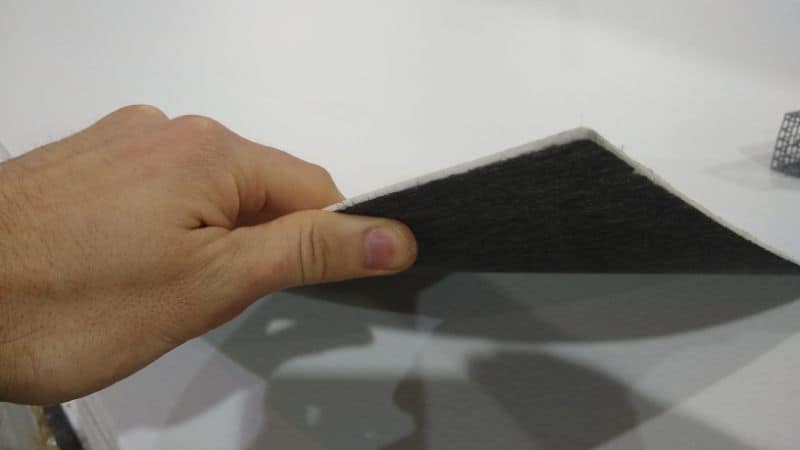
But the conflict of this story really isn’t between the hero and villain; it’s between the hero and the damsel.
Azdel has no trouble slaying lauan plywood. But even with the dragon defeated, why have so many RV manufacturers spurned Azdel’s affections?
Let’s begin with the backstory of our villain. (Alright, that’s enough of my Arthurian metaphors.)
Fade to black …
The Villain: What Is Lauan Plywood?
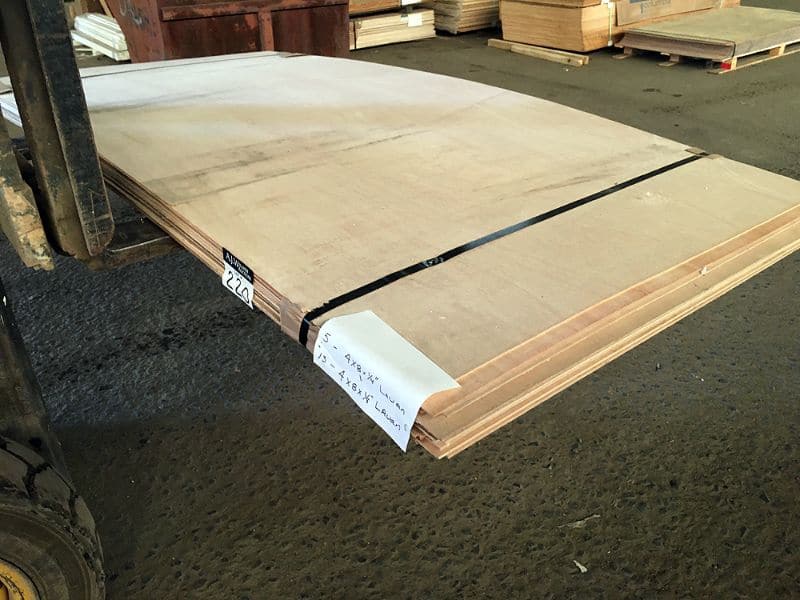
There are two opposing stories about what lauan* plywood is. (It’s also lazily misspelled as luan).
One party argues that lauan plywood is a miracle of engineering.
- An incredibly thin plywood panel (normally 2.7 or 3.6mm for the RV industry) that is lightweight, water-resistant, and relatively flat.
- It’s a plywood panel laminated from plies of Philippine mahogany (aka Meranti) veneer sourced from southeast Asia.
- There’s no comparable product in the world (certainly nothing domestic!) when it comes to thin, lightweight, 100% veneer hardwood plywood.
The other party argues that lauan plywood is a glorified piece of junk.
- A cheap 4×8 sheet of plywood that warps, ripples and bows as soon as you look at it.
- The plywood isn’t made with marine-grade WBP glue, so it delaminates with exposure to moisture.
- It has no businesses being used in RV construction, they say, where extreme swings of humidity and temperature are normal, and wood hates both.
Which story is true? My answer: Both of them.
Yes, in a certain sense, lauan is an incredible product. It’s an ultra-thin plywood (commonly used for underlayment) that can bend like a plastic sheet, but still hold a screw or a staple.
Don’t discount an RV just because it has lauan partitions or interior paneling. There’s nothing wrong with that. On the other hand, there are better alternatives than lauan for certain applications.
(Enter the hero, stage left …)
Where Is Azdel or Lauan Used in an RV?
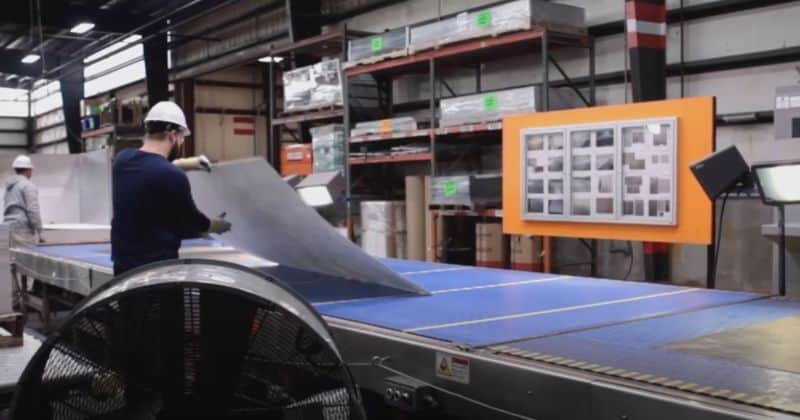
Azdel or lauan paneling is to RVs what drywall is to your house. You’ll find them everywhere:
- In laminated walls, they’re often the backer for your FRP skin
- In laminated walls, they’re also often the backer for your interior wallpaper
- Lauan/Azdel is used for most partition walls and access panel covers
- Lauan/Azdel is used as the backer for wallpapered ceiling panels, too.
- In some cases, luan or Azdel paneling might be used in a staggered “sandwich floor” design.
The Hero: What Is Azdel?
Azdel is a composite panel made from a proprietary blend of spun polypropylene and fiberglass fibers.
It’s typically available as faced 4×8 sheets at 2.7 or 3.6mm thicknesss.
It’s a wood-substitute, in many ways. And unlike lauan, it is produced right here in the good ol’ U.S. of A.
I’ll let Hanwha Azdel, the manufacturer, show you exactly what it is:
Pro Vs. Con Comparison: Azdel vs Lauan
Azdel Composite
Pros
- Lightweight! About half the weight of comparable plywood at the same thickness.
- Insulative! About 2x the R-value of plywood
- Cannot rot or disintegrate!
- Doesn’t grow mold or mildew
- Doesn’t warp or expand
- Muffles and dampens sound
- Does not delaminate
- Recyclable
- Formaldehyde-free
Cons
- Costs 50-100% more than lauan plywood
- Does not hold screws wells (requires wall anchors)
- Does not bond to many adhesives
- Paneling can be more easily dented or buckled
Lauan Plywood
Pros
- Affordable
- Good screw retention
- Easily fastened with screws, staples
- Accepts most adhesives
- Can be easily wallpapered or painted
- Easily bent around a radius
Cons
- Warps with exposure to heat and humidity
- Can crack or break
- Delaminates with moisture
- Absorbs water
- Can rot or mildew
- Transmits sound
As you can see, lauan plywood is easier to work with. That’s a big reason it’s favored by many manufacturers.
But as you can also see, Azdel is impervious to most of what Mother Nature can throw at it. And that’s why it’s favored by consumers.
Is Azdel As Good As They Say?
Lest this post devolve into an Azdel commercial, let me offer some constructive criticism.
I love Azdel. I really do. But it ain’t perfect. Here are my three biggest complaints:
- Awful screw retention. Azdel walls don’t hold screws or staples. I have found that using screw-in drywall anchors into an Azdel/foam wall works best, but you can also use regular hollow-wall plastic anchors.
- Overhyped insulation value. I’m sorry, but nothing 1/8″ thick has great R-value. (I debunked that myth here). We can throw around percentage improvements all day, but truthfully, Azdel won’t make much difference in heating or cooling your RV.
- It’s scratchy. It’s partial fiberglass, people! If you plan to work with Azdel yourself, cover up! You can use standard woodworking tools, but keep this stuff off your arms and out of your lungs.
I love that Azdel is so lightweight, but don’t kid yourself – you’re not saving more than 75-200 lbs, in most cases. Every pound is useful! – but Azdel alone won’t revolutionize your cargo capacity.
Does Azdel Delaminate?

Ah, you’ve asked the million dollar question!
For a full discussion of delamination, visit my other article. Then come back here.
No, Azdel doesn’t delaminate – in the sense that the panel itself won’t separate or disintegrate. Unlike plywood, Azdel doesn’t have layers. There are no glue lines that can fail.
And since inner-plywood delamination is a major source of RV wall failure, that means that an RV sidewall with Azdel will (as a rule) last longer, especially if there’s a leak!
However … if the bond between the fiberglass skin and the backer falls … then whether that backer is Azdel or lauan plywood. The wall “sandwich” has still separated..
Same story if the bond between the backer and the wall foam core gives away. If that bond breaks, the wall still fails.
The advantage of Azdel in either of these situations is that the wall could theoretically be repaired, even with a water leak. That’s much less likely with a lauan wall.
Should You Buy an RV Made with Azdel?
Yes, you should. Personally, I always recommend any RV with laminated fiberglass walls use Azdel for the exterior substrate. Full stop. Otherwise, this might happen to you:
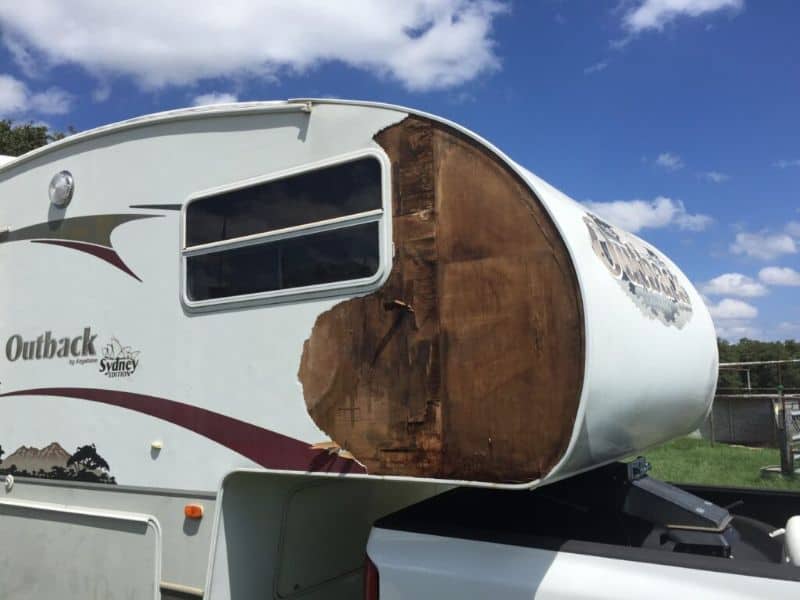
Here’s what I look for:
- Make sure Azdel is used for slide-out walls and extendable decks, too!
- If possible, I would also buy an RV with Azdel ceiling panels, too. Lauan plywood ceiling panels quickly stain and ripple with even minor roof leaks.
- Bonus points if the interior wall paneling is Azdel, too.
- Doesn’t really matter about material for interior partitions. Your preference.
In my experience, almost all RVs leak – eventually. Azdel might “not make a difference” to your RV for the first 10 years. But it might be the difference between your camper surviving a leak versus being hauled to the scrap yard. And to me, that cost premium is worth it.
Which RV Manufacturers Use Azdel?
There are a couple dozen RV brands that use Azdel. They’re all de facto members of the Azdel Onboard program, which is a marketing push from Hanwha Azdel.
If you walk around a dealership lot, look for a symbol like this:
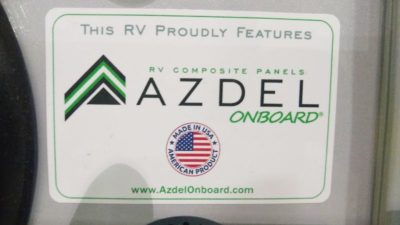
You can also research the full list of manufacturers here, at Changing Gears.
Here’s a snapshot of the major brands that have adopted Azdel in their construction processes:
- Heartland
- Coachman
- Lance
- Newmar
- NuCamp
- Winnebago
Many other manufacturers use Azdel in their premium travel trailer and 5th wheel lineups.
Will All RV Manufacturers Eventually Switch to Azdel?
Shoot. If only I hadn’t cracked my crystal ball last Thursday …
But this super-interesting news article from July 9, 2019, answers the question pretty well. The Big Players in the RV industry all joined up to convince the U.S. government to lift an 8% tariff on lauan plywood because there were no comparable products at the same price point.
And they got what they wanted. Uncle Sam took off the tariff, which saved the RV industry about $1 million per month.
Now, Azdel costs roughly 50-100% more than imported lauan plywood.
You really think an industry that lobbied against a measly 8% duty would pay up to 100% more for Azdel en masse?
So no, I don’t expect any tectonic shifts in the near future.
I do think the majority RV manufacturers that use laminated fiberglass walls will switch to Azdel for the exterior FRP backer, because the upfront cost of materials will be partially offset by reduced warranty claims.
However, I do think strong winds are brewing … (see next FAQ)
Are There Any Azdel Alternatives?
Azdel is the brand name for a particular product made by Hanwha Azdel, a subsidiary of Hanwha Advanced Materials, a South Korean conglomerate.
But other companies are getting greedy for a slice of the pie!
Elkboard
Elkboard is a similar polypropylene and fiberglass composite panel to Azdel. It’s foamed, not spun.
Who makes Elkboard? Well, it’s a complicated lineage. Elkboard is made by Elkhart Composites, which was acquired Airxcel in December 2021. Airxcel, in turn, is a subsidiary of Thor Industries, which owns roughly half the RV manufacturing industry.

Long story short: The biggest name in RV manufacturing is apparently investing millions of dollars into a composite panel similar to Azdel. That tells me that Azdel and its competition have a long, lustrous life ahead!
Currently, Elkboard is used only in Thor Industries products (see here for a full list of all brands owned by Thor). Thor doesn’t say exactly what brands get the product.
SymaLite
SymaLITE is sold by Quadrant, a subsidiary of Mitsubishi Chemical Advanced Materials Composites.
SymaLITE actually made its debut into the RV world quite a few years ago, but it was reserved mostly for the automotive industry. In recent years, it’s reappeared in many of the same places as Azdel, such as in fiberglass walls.
Compared to Azdel, SymaLITE is denser, heavier, and stronger. It has better screw retention and is available in roll material, not just panels.
SymaLITE may be a better product than Azdel for semi-structural uses, such as for laminated floors. However, with the introduction of TransCore, Transonite and other fused composite subfloors, I think the seamless fused options will edge ahead.
You can learn more about SymaLITE uses in RVs here.
RevolutionPly
Technically, RevolutionPly is more an alternative to lauan plywood than Azdel.
Made by Patriot Timber, RevolutionPly is an ultra-thin plywood made from laminated hardwood veneer. Unlike luan, which is made from harvested rainforest tropical trees, RevolutionPly is made from sustainable plantation species, like eucalyptus.
RevolutionPly is sold at Big Box home improvement stores like Lowes and Home Depot.
I’ve used RevolutionPly. It’s pretty good stuff! t’s heavier but hardier than lauan underlayment. Looks best when painted, though.
You can learn more Revolution Ply here.
What’s the Future for Azdel in RVs?
I believe Azdel is a harbinger of things to come. The RV industry is slowly switching to more composites, such as composite sandwich floors, thermoplastic membrane roofs, and now Azdel laminated fiberglass walls.
There will always be a place for simple wooden RVs, I think. Some families just camp 4-5x a year; they don’t want to spend $40,000 on a travel trailer.
But Azdel is just the beginning for premium RVs. Composites have revolutionized the auto industry; the RV industry will catch up eventually!
Leave a Reply